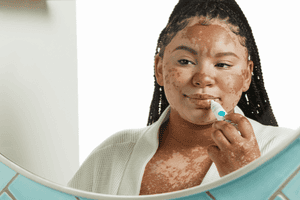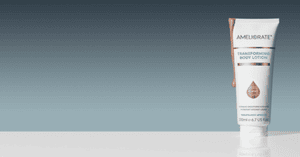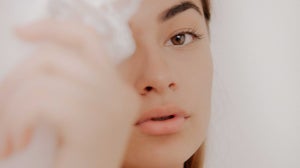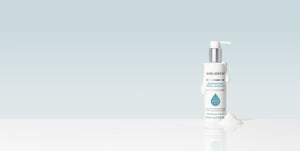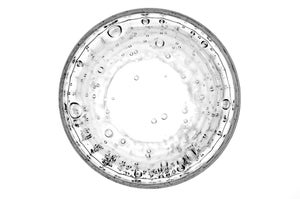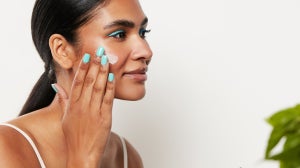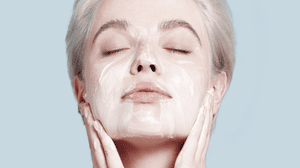
When your skin has made it through the turbulent water that is, acne, the least it deserves is to emerge the other end, clear, soft, and smooth. Unfortunately, life is not that easy. Instead, something called acne scarring exists. Acne scars are those pesky left-over marks once the blemishes themselves have cleared, and they just don't seem to budge. Granted, they are frustratingly stubborn to treat, however, it is possible to reduce the appearance of acne scars. What's more, with patience, a dedicated routine, and the right ingredients, you can reduce their appearance in the comfort of your own home.
Here's Ameliorate's guide on how to reduce the appearance of acne scars.
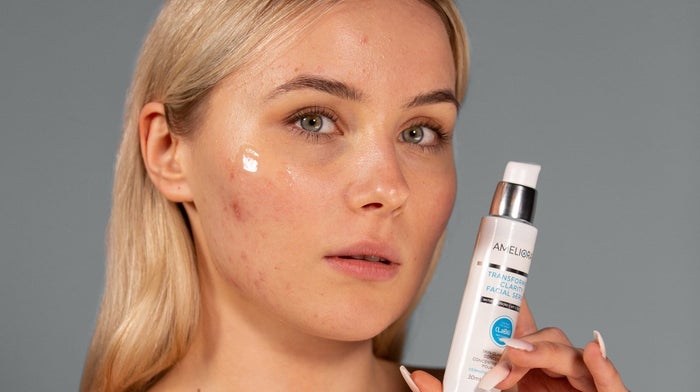
Why does acne leave scars?
First off, why oh why does acne leave scars in the first place?
Before we discuss this, it's important we explain the difference between marks and scars. Acne marks are those dark brown or red spots that are left behind once the blemish has healed. They are the skin's response to having a breakout and can last for days or weeks depending on how responsive your skin is. They are quite commonly experienced, and also commonly (and incorrectly) described as acne scars.
Acne scars are actual indentations in the skin and can be caused by severely inflamed acne, picking at blemishes, and the delayed treatment of acne. They affect the skin's texture rather than simply its pigment. Why acne leaves scars is down to the skin's healing process, and usually, two types of scars can result from this.
Why does acne leave scars that are pitted?
Firstly, we have pitted acne scars, which are often known as either:
- Boxcar scars: broad, box-like scars with sharply defined edges
- Ice pick scars: smaller, narrow indentations commonly found on the cheeks
- Rolling scars: similar to boxcar scars but with sloping edges that make skin appear uneven
Acne leaves scars that are pitted when your body tries to heal the damage by forming collagen. However, it doesn't quite form enough, leading to these indentations in the skin.
Why does acne leave scars that are raised?
Raised acne scars are the opposite of pitted scars. They are the result of your body overcompensating in its production of collagen to heal the wound.
Do acne scars go away?
As mentioned, acne marks do resolve eventually. With the help of certain skincare ingredients that work to brighten and resurface the skin, this process can be accelerated. However, do acne scars go away entirely?
According to Cleveland Clinic, "some acne blemishes are small and the scars created are shallow and heal quickly." However, the deeper the scars, the longer and more effort they require in order for their appearance to be reduced.
How to reduce the appearance of acne scars
The first step to reduce the appearance of acne scars, is to take control of the blemishes themselves. Once the blemishes have cleared, you can then proceed to deal with reducing the appearance of scars.
- Lactic Acid: One of the main causes of blemishes are blocked pores filled with oil and dead skin cells. Therefore, it's important to thoroughly cleanse every night to wipe your face clean and prevent build-up and inflammation. Ameliorate’s Clarifying Facial Cleanser is a non-stripping foaming cleanser specifically designed for blemish-prone skin. It contains our LaB6 Skin Clearing Complex which is a formula containing Lactic Acid and mild cleansing agents that work to mattify shine, remove excess oil, decongest and help even and smoothen the appearance of the complexion.
- Salicylic acid: This gentle exfoliant breaks down the bonds between dead skin cells so that they can release from the pores easier, clearing blockages. Plus, according to Healthline, it's considered to be one of the best treatments for acne scars. It also decreases the skin’s excess sebum production, leading to fewer breakouts and further preventing clogged pores.
- Retinoids: These work to clear blocked pores by sweeping away excess sebum, dead skin cells, and bacteria and stimulating the cell turnover of your skin. According to a 2017 review carried out by the National Library of Medicine, in addition to speeding up your cell regeneration and improving your skin’s texture, retinoids can also help reduce discoloration and make scars less noticeable.
- Niacinamide: This helps to reduce irritation and sensitivity and is also a great brightening agent to reduce any redness. It's gentle, works well with other ingredients, and can be used on any type of skin.
- Vitamin C: Finally, vitamin C works to brighten the skin tone and reduce the appearance of dark spots. While this ingredient alone won't improve any scarring itself, its anti-inflammatory properties can help reduce the redness and swelling that comes with acne and its scars.
Although this seems like quite a significant amount of new ingredients to add to your skincare regime, Ameliorate's Transforming Clarity Facial Serum is made up of a concoction of all of these ingredients, with Vitamin C, Niacinamide, Willow bark extract (a gentler version of salicylic acid) and Retinoids.
Remember, Rome wasn't built in a day. However the route to clearer, smoother skin involves dedication, cleansing, patience, and of course, the right ingredients. Discover our Blemish Range today.
Shop This Post:

Related Articles
